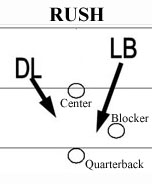
If your roster features lightning-fast athletes with good instincts for the ball, you will play a traditional Man coverage and blitz the remaining defenders assigned to the backfield blockers. This can get great pressure on the Quarterback, cut off outside running lanes, or force the Quarterback to roll away from his dominant arm to create a bad pass. All the while your coverage is insuring that every potential receiver is matched one-for-one with a defender.
If your roster is less athletic than your opponent’s Offense, you’ll likely resort to traditional Zone coverage, with an eye on covering large areas of the field and being in position to make smart decisions and sound, fundamental flag-pulls. The focus of the Zone defense is to delay or slow down the Offense, take advantage of a Quarterback’s mistakes, and force perfect execution from the receiver and the passer to make the play succeed. Zone can rattle less-talented or less-savvy Quarterbacks, especially ones with big arm strength but poor accuracy.
Defense is about executing the strategy with reaction and instinct. Thinking about where you are supposed to be, who you’re supposed to cover, what your “assignment” is on this play, that is where the coverage breaks down, the flag pull is missed, etc. So above all else, make your defense simple.
But your defense should not APPEAR to be so simple to your opposing Offense. That is the big secret. How do you infuse the appearance of complexity into a system that is very straight-forward?
Here are a few tips on how to achieve the appearance of complexity. Before we list them, remember this one basic rule: “If my players are confused, make it simpler. If my players are STILL confused, make it even simpler.” Confusion is the first sign of failure.
1. Pre-snap motion – Examples include linemen switching positions pre-snap, Cornerbacks bailing or running up to the line pre-snap, shifts in the secondary. Pre-snap motion can confuse less experienced QBs and help put defenders closer to the point of attack.
2. Live audibles – Defenses can change alignment, pressure, or coverage combinations with simple verbal cues from the Middle Linebacker. Use colors, numbers, or terms like “Omaha” or “zebra” to covertly communicate the change to your defenders.
3. Fake audibles – Better still, use lots of terms, letters, numbers, other colors that have no meaning (“48 Green! Strong Go! Razor-Razor!”) to make the Offense think you’re making major changes at the line. I would often designate one “hot” color to indicate a simple change, like Man to Blitz or Man to Zone, and tell the Middle Linebacker to improvise the rest to confuse their QB. Be sure your defenders know to ignore this chatter to minimize confusion.
4. Non-standard formations – Try different depths for the outside cornerbacks. Play with the starting position of your rushers, pinching them in or flexing them wider to the sidelines. Running your base package out of unique-looking formations can help disguise your base package for when you need it in the clutch.
5. Surprise assignments – Blitz from unexpected places, like the cornerback or safety positions. Drop your rushers into coverage. These tactics can often disrupt a QB’s decision making long enough to affect the play.
6. Monster Back / Lone Wolf – On occasion, allow your best defender to roam free anywhere they like. Give them the freedom to diagnose the play, blitz, drop in coverage, delay rush, or shift their location within the formation. By using it sparingly, the Monster Back technique will appear carefully scripted to the opposing QB, and that will make it harder for the QB to diagnose your base defense during the game.
Good luck!

 RSS Feed
RSS Feed